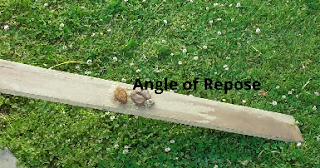Although you may not see it, gravity is a force of erosion. Gravity not only influences the movement of water, but it also causes rocks and soil to move downward. This downward movement caused by gravity called mass movement plays a major role in shaping the Earth.
Sand, rocks, and soil will move downhill until the slope becomes stable. The angle of repose is the steepest angle at which loose material will not slide downward. The angle of repose may change based on the size, weight, shape, and moisture level of the objects which may cause rock falls or landslides.
The most destructive mass movement happens suddenly and rapidly. A rockfall happens when loose rock falls down a steep slope. This steep slope may be manmade when creating a road or created by nature. Rocks that range in size from small fragments to large boulders fall down the slope due to gravity.
A landslide is the sudden and rapid movement of a large amount of material downward. A slump is the most common landslide and happens when a block of material moves downward over a curved surface. A rapid movement of a large mass of mud is a mudflow. When heavy rain mixes with soil and rock a slippery mass of mud may be created that can flow rapidly downhill. Mudflows as a result of a volcano are called Lahars. Volcanic eruptions or heavy rains on volcanic ash can cause a Lahar that may travel up to 80km an hour.
Sometimes the mass movement is very slow. This is called creep. Water loosens the soil on a steep slope, Plant roots and animals loosen the soil which slowly moves downhill. Bent tree trunks may be evidence that creep is occurring.






0 comments:
Post a Comment